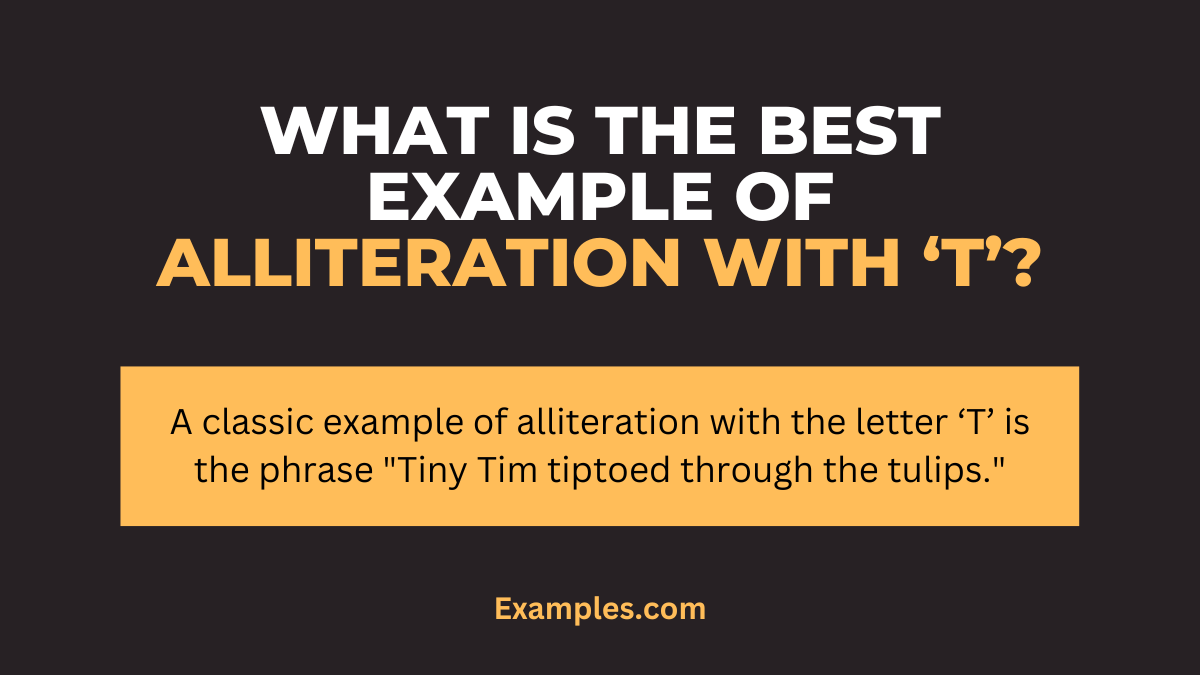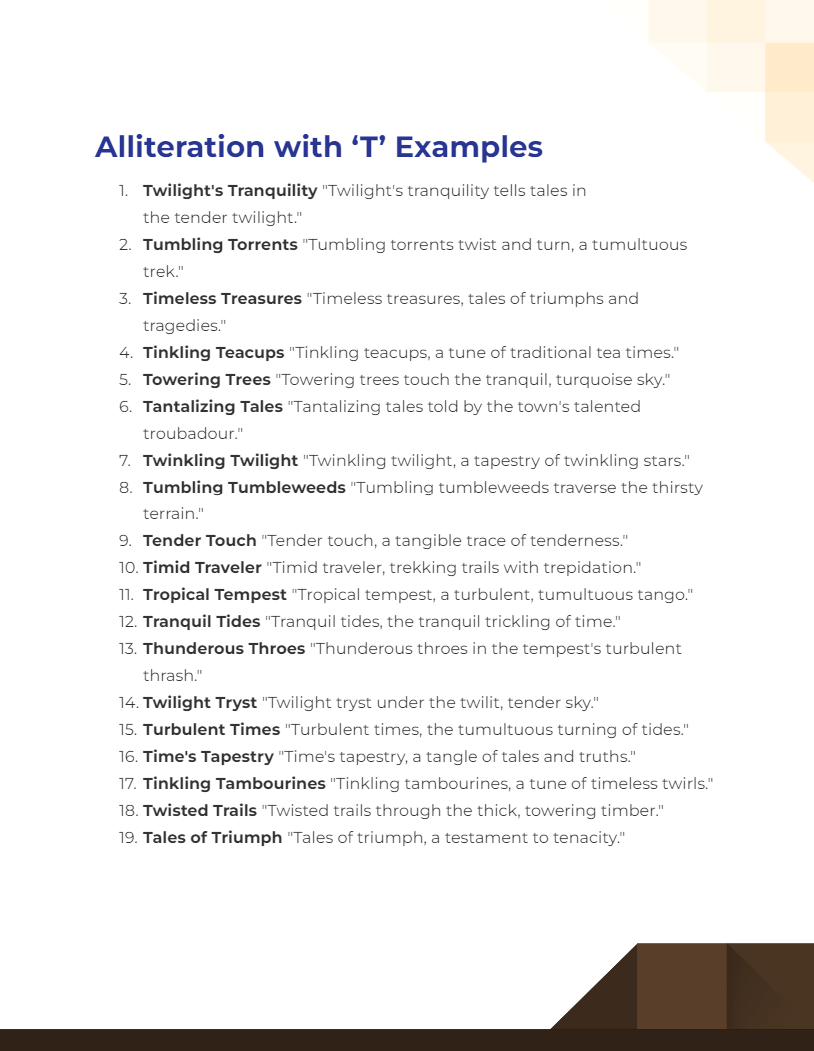19+ Alliteration with T Examples
Alliteration with the letter ‘T’ taps into the power of repetition to create a textured and tantalizing effect in writing. This technique, involving the repetition of the ‘T’ sound at the start of adjacent or closely linked words, adds a tuneful and rhythmic quality to the language. It is particularly effective in setting a tone, building atmosphere, or emphasizing key points in both poetry and prose. The crisp, clear sound of the ‘T’ can bring a sense of precision and impact to your writing, making it more memorable and engaging. When skillfully used, famous alliterations can transform a simple phrase into a striking piece of literary art, leaving a lasting impression on the reader or listener.
Download Alliteration with 'T' Examples
Download Alliteration with 'A' to 'Z' Examples
What is the Best Example of Alliteration with ‘T’?

Example: A classic example of alliteration with the letter ‘T’ is the phrase “Tiny Tim tiptoed through the tulips.”
Meaning: Alliteration is a literary device that involves the repetition of the initial consonant sounds in a series of words within a sentence or phrase. In the example “Tiny Tim tiptoed through the tulips,” the consonant ‘T’ is repeated at the beginning of several words, creating a pleasing and rhythmic sound pattern. Alliteration is often used in literature, poetry, and tongue twisters to enhance the auditory experience of language. In this particular example, the easy alliteration repeated ‘T’ sounds evoke a sense of delicacy and lightness, mirroring the image of someone moving quietly among flowers.
20 Alliteration with ‘T’ Examples

Download Alliteration with 'T' Examples in PDF
Alliteration with the letter ‘T’ weaves a tapestry of tantalizing and tuneful twists, creating a textural and often tantalizing auditory experience. The ‘T’ sound, known for its crisp and sometimes terse quality, is adept at crafting hard alliteration examples. Especially effective in alliteration in rhymes, the ‘T’ sound adds a rhythmic and engaging dimension to verses. Here are 20 unique examples of alliteration with ‘T’, each complemented by a rhyme title that encapsulates the essence of the phrase.
- Twilight’s Tranquility “Twilight’s tranquility tells tales in the tender twilight.”
- Tumbling Torrents “Tumbling torrents twist and turn, a tumultuous trek.”
- Timeless Treasures “Timeless treasures, tales of triumphs and tragedies.”
- Tinkling Teacups “Tinkling teacups, a tune of traditional tea times.”
- Towering Trees “Towering trees touch the tranquil, turquoise sky.”
- Tantalizing Tales “Tantalizing tales told by the town’s talented troubadour.”
- Twinkling Twilight “Twinkling twilight, a tapestry of twinkling stars.”
- Tumbling Tumbleweeds “Tumbling tumbleweeds traverse the thirsty terrain.”
- Tender Touch “Tender touch, a tangible trace of tenderness.”
- Timid Traveler “Timid traveler, trekking trails with trepidation.”
- Tropical Tempest “Tropical tempest, a turbulent, tumultuous tango.”
- Tranquil Tides “Tranquil tides, the tranquil trickling of time.”
- Thunderous Throes “Thunderous throes in the tempest’s turbulent thrash.”
- Twilight Tryst “Twilight tryst under the twilit, tender sky.”
- Turbulent Times “Turbulent times, the tumultuous turning of tides.”
- Time’s Tapestry “Time’s tapestry, a tangle of tales and truths.”
- Tinkling Tambourines “Tinkling tambourines, a tune of timeless twirls.”
- Twisted Trails “Twisted trails through the thick, towering timber.”
- Tales of Triumph “Tales of triumph, a testament to tenacity.”
- Tender Thoughts “Tender thoughts turn to timeless, treasured memories.”
Alliteration Sentence Examples with ‘T’
Alliteration sentence examples with ‘T’ often produce a tactile and tuneful tone, utilizing the ‘T’ sound to create a textured and rhythmic narrative. This type of alliteration is a staple in various literary forms, including alliteration in poems, songs, and movies, where it adds a memorable melodic quality. Here are three examples:
- “Tommy’s tiny toy truck tumbled through the tall tunnel.”
- “Tina’s tulips trembled tenderly in the twilight breeze.”
- “Timothy took the telescope to the towering treetop terrace.”
Alliteration Examples with ‘T’ Words
Alliteration examples using ‘T’ words demonstrate the power of this consonant in creating vivid and impactful phrases. Frequently employed in alliteration in songs, the ‘T’ sound adds a crisp, engaging element. Here are three examples:
- “Tantalizing tastes of tropical fruits tantalized their taste buds.”
- “The tranquil temple stood timeless atop the terraced hill.”
- “Thundering thuds trembled through the timbered terrain.”
Alliteration Examples with ‘T’ Name
Incorporating names that start with ‘T’ in alliteration adds a personal touch to phrases, making them more relatable and vibrant. Here are three examples:
- “Tara’s twinkling tiara twinkled atop her tresses.”
- “Travis trudged through the thick thicket tirelessly.”
- “Tiffany’s tender touch tamed the timid tabby cat.”
Alliteration Examples with ‘T’ Sound
The ‘T’ sound in alliteration can produce a range of effects, from light and airy to deep and resonant. These examples show diverse applications of the ‘T’ sound in alliterative structures. Here are three examples:
- “Tiny tadpoles twitched and twirled in the tranquil pond.”
- “Twilight’s tender touch transformed the tranquil town.”
- “Tumultuous tides tore through the tranquil bay tumultuously.”
Alliteration Poems with ‘T’
An alliteration poem with ‘T’ uses the repetitive ‘T’ sound to create a rhythmic and engaging poetic experience. Alliteration in poems, especially with the ‘T’ sound, brings a unique lyrical quality. Here are three examples:
- “Twinkling stars in the tranquil night, / Telling tales in the twilight’s light.”
- “Tall trees talk in the trembling breeze, / Telling tales of the tempestuous seas.”
- “Time travels through the ticking clock, / Telling tales of the tock and knock.”
Alliteration Beginning with ‘T’
Alliteration beginning with ‘T’ sets a specific tone and rhythm in a phrase, often creating a memorable and impactful auditory experience. Found in various artistic expressions, including alliteration in movies, it adds a distinctive flair. Here are three examples:
- “Tanya’s teacakes tempted the townsfolk at the tea party.”
- “The timid tiger tiptoed through the tall grass tentatively.”
- “Tranquil tunes transcended from the traditional tambourine.”
How to Write Alliteration with ‘T’?
Writing alliteration with the letter ‘T’ involves the deliberate placement of words starting with the ‘T’ sound in close sequence within sentences or phrases. The ‘T’ sound, known for its crispness and clarity, can add a rhythmic and sometimes dramatic tone to your writing. This technique is versatile, used across various contexts, including educational settings like alliteration for first grade and more complex alliteration in figurative language compositions. Here’s how to craft effective alliteration with ‘T’:
- Understand the ‘T’ Sound: Get familiar with the ‘T’ sound, which is sharp and clear. It’s a consonant that can bring a strong rhythmic quality to your writing.
- Choose a Theme or Concept: Select a theme or subject. This aids in finding relevant ‘T’ words that fit your context, whether you’re creating alliteration with answers or for creative expression.
- Brainstorm ‘T’ Words: Compile a list of words starting with ‘T’. Include a mix of nouns, verbs, and adjectives to enrich your alliteration.
- Construct Your Phrase or Sentence: Create a sentence or phrase using your chosen ‘T’ words. Aim for a natural flow that emphasizes the alliterative effect.
- Read Aloud for Rhythm: The effectiveness of alliteration is often best judged audibly. Read your sentence aloud to ensure it has a pleasing rhythm.
- Revise for Clarity and Impact: Make sure your alliterative phrase is clear and contributes effectively to your overall message or story.
- Apply in Various Contexts: Whether it’s in alliteration figurative language exercises, as part of teaching alliteration for first grade, or in creative writing, adapt your use of ‘T’ alliteration to suit the purpose and audience.
Tips for Using Alliteration with ‘T’
Here are the Tips for Using Alliteration with ‘T’:
- Use Sparingly: While alliteration can enhance your writing, overusing it can become overwhelming. Use it to emphasize key points or add stylistic flair in moderation.
- Maintain Clarity: Your primary goal is to convey a message clearly. Alliteration should complement, not complicate, your narrative.
- Vary Word Length and Complexity: Mix short and long ‘T’ words, as well as simple and complex words, for a more dynamic textual rhythm. This is particularly important in alliteration for first grade, where simpler language is necessary.
- Consider the Mood: The ‘T’ sound can be energetic and commanding or soft and soothing. Use it in contexts where this mood is appropriate.
- Read and Revise: Reading your work aloud helps you assess the rhythm and flow. Adjust as needed to ensure the alliteration enhances the text.
- Appropriate for Audience: Tailor your alliteration to your audience. For instance, alliteration for first grade should be simpler and more playful than alliteration for adults.
- Explore Different Forms: Experiment with ‘T’ alliteration in various forms of writing, from poetry and stories to advertising and academic work, to understand its effect.
Remember, the key to effective alliteration with ‘T’ is balancing its distinct sound with readability, ensuring that the alliterative phrases enhance your writing.
What are the Alliteration with ‘T’ for Kids?
Alliteration with ‘T’ for kids involves creating fun and engaging phrases using words that start with the ‘T’ sound. This form of alliteration is great for early language development, helping children with phonetic awareness and making learning enjoyable. For kids, ‘T’ alliterations are often playful and easy to memorize. Here are some examples:
- “Tommy’s tiny tiger toy took a trip to the tall tree house.”
- “Tina’s two turtles tap-danced on the tiled terrace.”
- “Timothy told tales of ten twinkling stars to his teddy bear.”
These alliteration examples are specifically designed for alliteration for kids, focusing on simplicity and fun.
What is the Effect of ‘T’ Letter in Alliteration?
The effect of the ‘T’ letter in alliteration is to create a crisp, clear sound that can add rhythm and emphasis to language. The ‘T’ sound, being a plosive consonant, has a sharp and sometimes forceful quality, making it effective for drawing attention to specific phrases and enhancing the rhythmic quality of the text. In literature, ‘T’ alliteration is often used to set a particular mood or to add a dynamic quality to the narrative. It’s a versatile sound, suitable for all audiences, from alliteration for kids, where it can be playful and light, to more sophisticated literary works for adults. The ‘T’ sound plays a significant role in both alliteration and assonance, contributing to the overall sonic appeal of a piece.
What is the Alliteration ‘T’ Type of?
Alliteration with the letter ‘T’ is a type of consonantal alliteration, where the consonant sound at the beginning of adjacent or closely connected words is repeated. This type of alliteration is common and effective in various forms of writing, from creative poetry to prose. The ‘T’ type of alliteration can create different effects, ranging from light and playful to more forceful and pronounced, depending on the context and the words chosen. This form of alliteration is seen in a wide range of literary contexts, from educational materials like alliteration for students to more complex compositions for adults. It is often used in conjunction with alliteration and assonance exercises to explore the sonic qualities of language. The ‘T’ type of alliteration is valued for its ability to add a rhythmic quality to writing, enhancing its impact and memorability.


